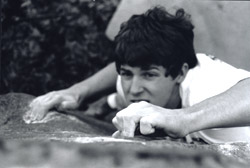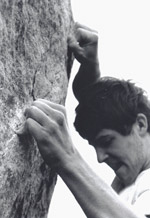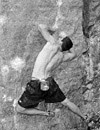





Vertical Reality:
Wisconsin
climbers in their element
by Marni Foerster
 |
| Climber Peter DeSalvo reaches for a hold
at Hueco Tanks State Park in Texas. Photo by Marni Foerster. |
On the
side of Van Hise Hall at UW-Madison stands a stark brick wall. Hundreds
of people pass in
conversation without giving the wall a second glance. They look at each
other or the cars whizzing by or the rush of students funneling down the
sidewalk. But occasionally, someone looks intently at the bricks as they
pass, pausing their conversation. They may stop to touch the grainy imperfections
in the stonework, the dime-sized edges just thick enough to crimp with
their fingers and smear with their feet. It’s no longer a simple
brick wall; they see a challenge.
This is not only happening at Van Hise. It’s happening at brick
buildings all over Wisconsin as more people begin to look at the world
through climbers’ eyes.
A
misunderstood sport
Climbing
gyms across the state have seen consistent growth in visitors in recent
years. Climbers live in virtually every city, scaling rocks and climbing
walls in garages, camps, elementary schools, malls and indoor gyms. Some
even climb buildings, marking their territory with white chalk residue
from their fingers as they go. Yet despite the sport’s growing mainstream
appeal, climbing and climbers remain largely misunderstood.
Media hype has commercialized “extreme” sports like climbing,
making them more marketable and fashionable. As climbing became trendier,
the entertainment industry cultivated many misperceptions about the sport.
“You get a lot of people who have seen ‘Cliffhanger,’
or more recently ‘Vertical Limit,’ and they want to do things
like hang upside-down and swing around on the rope, or the Tom Cruise
thing where he turns backwards against the wall,” Boulders Climbing
Gym General Manager Todd Mei says.
Even the basic concept and purpose of climbing are often misunderstood.
“We get a lot of people who come in here and the first thing they
ask is, ‘what’s your fastest time up the wall?’ And
they get that from the X Games. They have no idea about difficulty of
movement, but they just think it’s a race to get up the wall,”
Mei says.
The news adds to the inaccurate portrayal at times, as well. Steve Frye,
Wisconsin Outdoor Access vice president and Access Fund regional coordinator,
says Wisconsin’s local media often depict climbers as daredevils
and risk-takers by misclassifying non-climber accidents near cliff lines
at Devil’s Lake State Park and Gibraltar Rock as climbing-related
accidents. Most times, he says, “It’s hikers, campers, drunks,
kids, families, suicides, you know, everybody else [that gets injured]
… Climbers now are a very safe bunch. They’re climbing for
recreational pursuits, not climbing to see whether they can live or die.”
 |
| Peter DeSalvo of Madison on the Nacho Man
climb at Hueco Tanks State Park in Texas. Photo by Marni Foerster. |
Beyond
the tarnished image
People
from all walks of life form Wisconsin’s close-knit climbing community:
business professionals, budding slackers, students and families. They
range in age from 3 to over 50, though most fall between 10 and 40. Males
outnumber females, but the gap is slowly shrinking.
People take up the sport for numerous reasons. Many initially try climbing
to appease curiosity that has grown with exposure to the sport through
movies, the media or friends. They often seek adventure. Some who have
a passion for another “extreme” sport like mountain biking,
kayaking or mountaineering find a similar appeal in climbing.
Others begin because they want to challenge themselves physically and
mentally but have tired of team sports or typical workouts. “People
are looking for alternative means of exercise—things that are not
only physically exerting, but things that have some sort of quote-unquote
spiritual aspect, a focus on trying to push yourself hard,” Mei
says.
Climbing seems to have an addictive quality. Many first-time climbers
return for more and more. They try it out and feel the thrill of the height.
They work hard to perfect a climbing sequence, and finally everything
comes together as they flow through the movements, with precise foot placement
and nimble body positioning. When they climb until their fingertips are
raw and they can feel the climb aching in muscles they never noticed before,
they know their workout is complete.
 |
| Peter DeSalvo cranking while on a road trip
at Texas’ Hueco Tanks State Park. Photo by Marni Foerster. |
A small
but distinguishable group of climbers takes the sport a step further.
For these rock addicts, climbing isn’t just a hobby or sport. As
avid climber David Barylak puts it, “Climbing is more like a lifestyle.”
Seventeen-year-old Barylak works 30 hours a week at Adventure Rock Indoor
Climbing Gym in Pewaukee, then tries to pack in three to four climbing
sessions as well.
Once a person is committed to climbing at this level, it gets into the
bloodstream. Instead of comparing new clothes with their friends, this
unique group compares calluses and shoe rubber. The world becomes their
climbing gym—it’s second nature to momentarily grab a stone,
a toothbrush, a car door handle and envision it as a climbing hold. It’s
what they think about, read about and talk about.
The motivation for a life that revolves around climbing comes from deep
within. “I have this incredible passion for climbing that I can’t
suppress, even if I wanted to. That’s my greatest goal—while
I’m teaching, when I’m climbing—I want to be able feel
that and to spark that,” says Madison climber Peter DeSalvo, whose
life follows a regimen similar to Barylak’s.
Being committed can consume one’s life; however, it is not necessarily
synonymous with having superstar climbing abilities. Ultimately, Mei says,
it comes down to pursuing climbing as a passion for oneself rather than
to fulfill a competitive drive.
DeSalvo says climbers reach the hardcore status when climbing goes from
being a recreational pursuit for fitness or fun to pushing oneself to
the limit, problem solving, conquering a challenge, being surrounded by
nature and connecting with the rock.
 |
| Peter DeSalvo gives in to gravity while climbing at Devil’s Lake State Park. Photo by Marni Foerster. |
Wisconsin’s
scarcity of rock often forces climbers to drive hours to the state’s
few areas with substantial rock concentration, such as Devil’s Lake
State Park or Governor Dodge State Park. Still, DeSalvo says, Wisconsin’s
climbers make the most of the situation. “They don’t take
the rock we do have for granted. Also, they have the determination to
go climb other places even when it’s a long ways away … Climbers
are always in pursuit of the perfect rock.”
A distinct road-trip culture has emerged with this mindset. A typical
road-trip weekend—roughly one or two weekends a month for DeSalvo
and Barylak—might include a steady diet of cliff-hopping and granola
bars between eight-hour stints in the car. These trips form a sense of
social continuity that tends to establish unique bonds among climbers.
“Especially on road trips, you get to know people much better than
you would with a normal friendship. You rely on each other—especially
when climbing. There’s a level of trust that’s sometimes overlooked,
but is always there,” DeSalvo says.
In the gym
A unique bond can be seen among Wisconsin’s climbers at all levels
of the sport. Regardless of whether the climbers are new or experienced,
it’s common to hear strangers encouraging each other in the gym
as they climb. Mei calls it the “Midwest mentality,” noting
its sharp contrast to his experiences growing up in the West. He says
one of the first things people notice about Wisconsin climbers is how
friendly they are. “They’re much more relaxed—more Midwest.
People aren’t there to put up an appearance about themselves,”
he says.
 |
| Jesse Matner and Peter DeSalvo admire the view from the bottom of “The Gymnasium” climbing area in Hueco Tanks State Park. Photo by Marni Foerster |
Gyms
have become a social haven as much as a place to climb. Barylak says the
social atmosphere at Adventure Rock is most potent on designated member
nights, when many of the gym’s regulars stop in to climb hard and
chill out. “Usually people have just gotten back from road trips
to the Red River Gorge or wherever, so we’re looking at pictures
or hanging out. There’s not always a lot of climbing going on,”
Barylak says.
Most days,
the gyms are buzzing with regulars, occasional climbers and plenty of
new blood. On quiet nights or after hours, hardcore climbers have been
known to do odd things like try climbing around a chair without tipping
it or try ascending an unopened ladder in an effort to perfect their balance.
But these nights are rare. Since roughly one-fifth of the average Wisconsin
climbing gym’s revenue comes from birthday parties, chaos often
reigns.
With the increased traffic, DeSalvo sees more people at all levels enjoying
the sport’s physical, mental and social aspects. “I love it
when you can tell that somebody’s completely passionate about climbing.
And I like that there are more people to relate to—more people interested
in the same thing you are,” he says.
Even with the increased interest, the number of committed Wisconsin climbers
is still relatively small. Mei puts the number at roughly 5 percent of
the state’s climbers. But their impact on the sport is unquestionably
larger. Less experienced climbers watch in awe as the hardcore climbers
deftly dominate the wall with grace. They listen to the tales of road
trips; they take in the pictures of menacing multi-pitch climbs and serene
landscapes. Most people will continue with their lives whizzing by, caught
up in the world’s many distractions. But occasionally, someone feels
inspired. Their focus shifts as passion takes hold. They begin the never-ending
search for the perfect rock. And along the way, they look intently at
the brick walls as they pass.
Home | Cruising | Refueling | 20 Pt. Inspection

